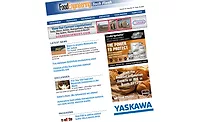Why Sabra redesigned its hummus packaging
Eugenio Perrier, Sabra’s CMO, talks about keeping the clear window, changing the sun and listening to consumers.

Sabra Dipping Company, known for its hummus has introduced an updated packaging and a new logo.
Sabra catapulted into the snack scene in the past decade as Americans discovered the joys of hummus. The company currently has about 60 percent hummus market share, and also makes other dips, including guacamole and Greek yogurt-based tzatzikis.
Recently, the brand unveiled a fresh logo and packaging redesign for its complete product line. The rebranding includes an updated logo, restyled label design and original on-pack photography highlighting the fresh, plant-based ingredients in Sabra products.
Eugenio Perrier, Sabra’s CMO, recently took some time to talk about why the company felt compelled to redesign its famous packaging, why they kept the clear window and why the sun wasn’t as important as they thought it was.
Food Engineering: What inspired the company to do the packaging redesign?
Perrier: We see this as part of a natural evolution for the brand. Thankfully, Sabra’s packaging was still working quite well. But we felt at this time, the packaging could work even harder for us at communicating important brand attributes and messages on pack. We feel the new design enhances flavor expectation and beautifully convey Sabra’s brand personality and promise.
Great design plays a critical role in communication and begins a conversation between brand and consumer, offering a glimpse at the product and brand promise. At the core of the redesign is our logo. The Sabra sun has been recast as inviting chickpea sun, evoking warmth and heart, surrounded by sesame seed rays of light that represent our core ingredients and core values. We are passionate about creating fresh new ways of eating and connecting and as consumers embrace a fresh approach to nourishment and seek out more great tasting plant-based options, it was the perfect time to rejuvenate and unify the brand’s look and feel.
Food Engineering: How did you balance having a look that consumers would still easily associate with the brand, with also coming up with something new?
Perrier: Since we knew we didn’t have a packaging problem but instead an opportunity to improve, early on, we determined which elements needed to remain, like the red rim and the transparent packaging so that consumers can see through to the delicious products. But we did have flexibility on other elements. This was a great opportunity to better communicate our brand and the fresh ingredients within our products. It was also clear that as we have grown our product portfolio, we have not always integrated new line extensions as powerful as possible – which sometimes made it difficult for consumers to find their favorite flavor or discover something new on shelf. The new packaging dramatically improves the shop-ability across all product lines.
Food Engineering: What was the most challenging thing about the redesign?
Perrier: In general, this was a great process and since we had the advantage of time, we enjoyed the journey and loved listening to consumers along the way. One challenge rested with the Sabra sun and honestly this is an element we are most proud of at the end of the day. We had thought of the sun as an important way to pay homage to Mediterranean heritage yet when we listened to consumers, they were really not even noticing the sun. It was not nearly as critical as we had thought. So, we decided to explore the possibilities and that allowed us to take a beautiful step forward.
The sun recast as inviting chickpea sun is surrounded by sesame seed rays of light that represent our core ingredients and core values. We arrived at this chickpea sun because it synthesized a lot of what we want to be- communicating that Mediterranean heritage, representing the chickpea which is our main ingredient and including the 5 rays of sesame seeds – the other key ingredient in hummus.
Food Engineering: Why was it so important to keep the clear window?
Perrier: Sabra pioneered that packaging, and many credit that packaging innovation for helping drive the explosion of interest in hummus in the past decade. The ability to look through the package and see the beautiful texture, the freshly colorful vegetables and get a sense of the product quality. Of course, other smaller brands then adopted that form of packaging and that’s ok. We applaud transparency everywhere in the food industry and are thrilled to have maintained that element while really taking a big step forward with the design insofar as it really puts the spotlight on the fresh ingredients and making it significantly easier to shop for a favorite flavor or discover something new.
Food Engineering: Anything else you would like to add?
Perrier: Really just a bit of a funny story. My first day on the job as CMO at Sabra didn’t take place in the office. The team had focus groups scheduled already and I joined in – so in a way the first input I had about the brand in my role was from consumers, not my colleagues. We were soliciting input about packaging and what did I learn? That our packaging was working really well so there was nothing for me to do there, right? In reality, though, it meant there was no immediate need to change so we took our time and like all aspects of a brand, it is always the right time to be thinking about the future.
Looking for a reprint of this article?
From high-res PDFs to custom plaques, order your copy today!








